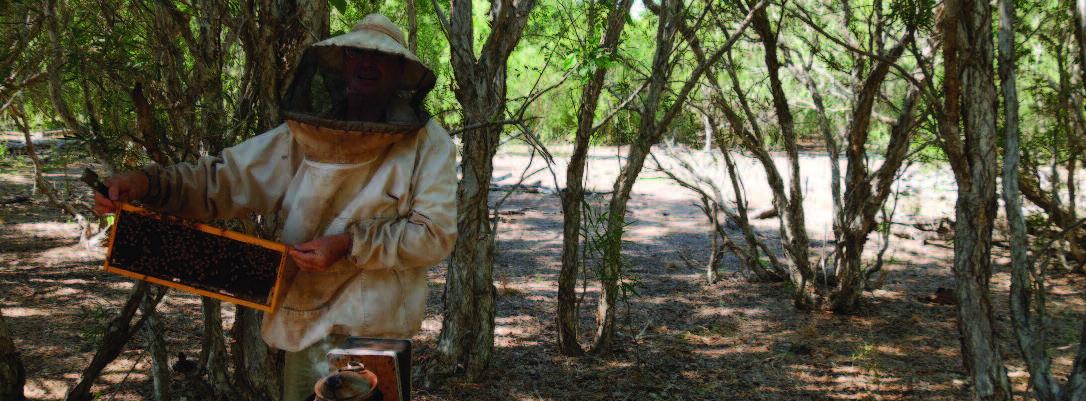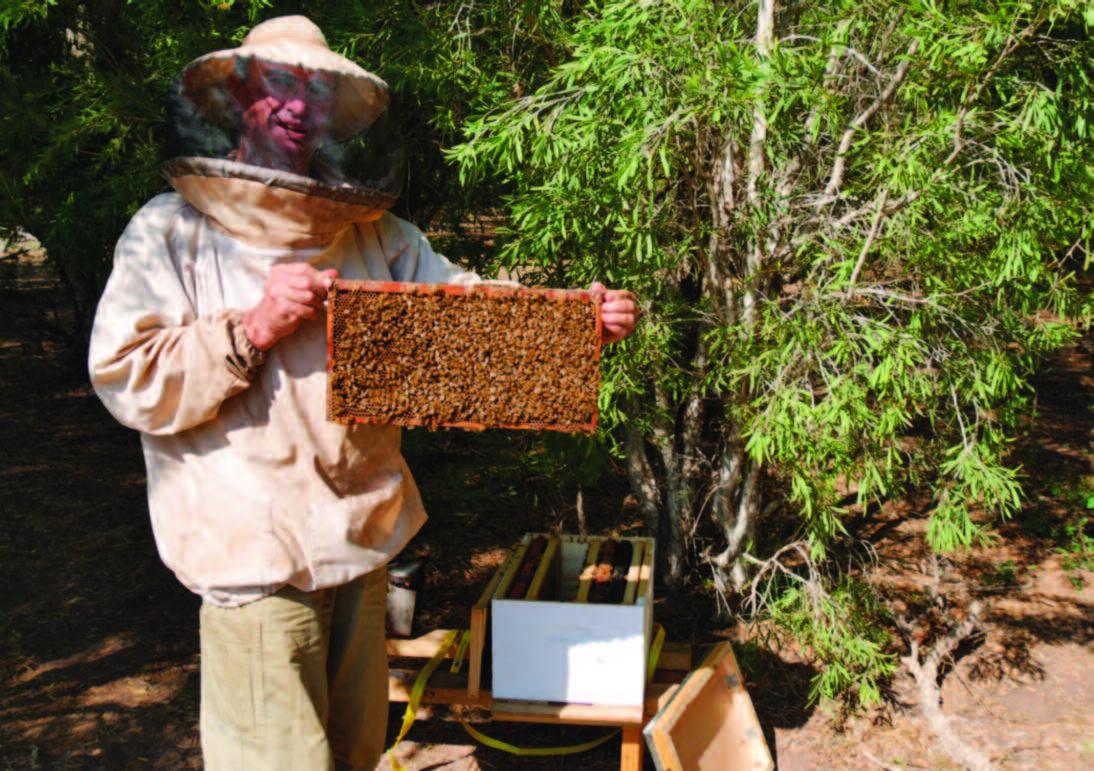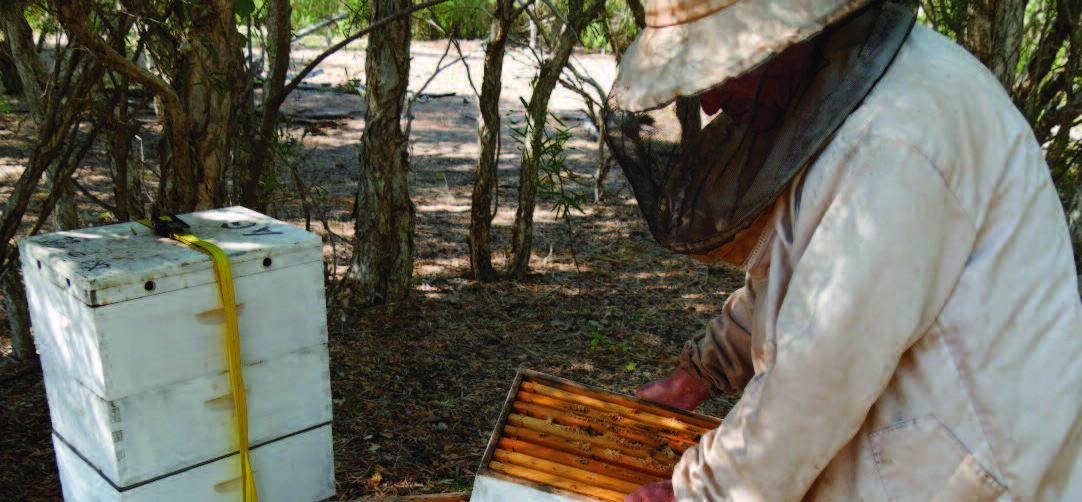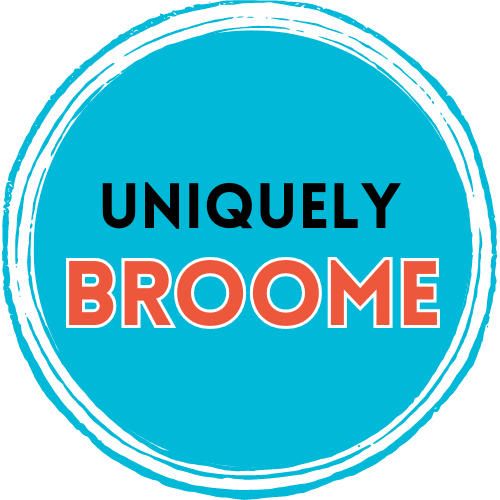
2018 - RAW BUSH HONEY
While courting his wife 36 years ago, Dave Appleby recalls being out in the bush with Dianne and her mother. “The old girl would show us how they got honey from the stingless native bees. They used to put it on kids’ sores and take it for stomach ailments and coughs, which they called ‘cold sick’. She called the saltwater melaleuca the medicine tree.” said Dave. Little did he know that these outings would eventually lead him to bee keeping himself, years later.
Buying local produce ensures you're getting the freshest possible. Much of what we eat in Broome has travelled thousands of kilometres to reach our table. David Appleby is passionate, enthusiastic and he learned a new skill later in life. He invited me to visit his hives on Roebuck Station and learn more about bees and honey.
What brought you to Broome?
I had my commercial diving ticket and knew a lot of old pearling skippers from back east where I was from, so it was natural to get into the industry here in Broome. I dived for a total of 14 years, seven with Allan Badger and seven with Kim Male. I did a bit of skippering and was offered a job as a Training and Safety Officer, which I worked in for 10 years. That work included looking after the hyperbaric unit or divers’ chamber at the hospital. If we ever had a diver with the bends admitted, under guidance of the doctor, he would get the correct medical procedure. We only had two or three minor bends each season which wasn’t bad considering there was a lot of diving in the pearling industry. Since 2000, I have been working for the Department of Corrective Services.”
When did you start keeping bees?
“About five years ago someone gave me a hive. A friend had a couple of hives and I had been helping him and it just grew from there. My first hive failed, and I had to make a decision: do I just forget about it or learn more? I learnt more. It was really fascinating. I needed another queen. You can get them sent by post. I had four queens sent up, but after a disaster with the post I learned to graft my own. I met a couple of beekeepers in Perth who recommended a breeder to me. He helped me set up my own apiary here, so I no longer had to worry about where to get my queens. This is my third year with these hives, and I have 120 now. I started meeting people and learning. I don't mind ringing people up for advice and I get some great and some not so good. But I am learning all the time.”
Why are you so passionate about honey?
“Dieticians will tell you that processing food compromises peoples’ nutrition. Unprocessed food has many benefits. So, let’s get back to basics: what is so good about honey? It is the same thing with this raw food craze that is going on. These little bees take pure nectar from flowers and store it. As I started learning from beekeepers, I began having more raw honey in my diet. Five years ago, I was a diabetic and much heavier. My diabetes is now in remission, and I reckon it has to do with the honey. Plus, I keep well away from refined sugar.” “My honey is straight off the cone. I scrape it off without using any heat. In colder places, they need to use heat or steam to collect the honey. Here we have the perfect climate. I spin it by hand with a centrifugal extractor into a stainless-steel container, then through a triple filtration system, ending up with pure honey. The honey sells itself.” It was time now to go and meet the bees. We were out at Roebuck Plains Station in a lovely grove of melaleucas, and it was nice and shady. I could smell a sweet and very faint perfume. It was time for more questions.”
Why do you use smoke when opening a hive?
“When the queen senses danger she releases a pheromone to warn the bees that something is wrong. Smoke disguises the smell of the pheromone, so they don’t think anything is wrong. In a big hive, you could have up to 30,000 or 40,000 bees so you want to make sure they don't feel threatened.”
What do you look for when you’re checking your hives?
“I’m looking for eggs the queen has laid. They are like grains of rice. These eggs are about a day old. They grow during the larva stage within the cells that are capped by the worker bees. They pupate then hatch out as bees. I am expecting some healthy young bees soon.” “When the melaleuca stops flowering, I will need to move these bees to where there's more trees in bloom. If they run out of flowers, the hives suffer. Luckily this hive is full of honey right now.” “The hives are made of pine, a very good quality from New Zealand. I have to put the boxes on t hese metal stands to keep white ants away. The bees collect nectar and pollen from the flowers. See those bees coming back into the hive. They have pollen on their legs. There's a wattle that flowers around here and the nectar carries about 27 proteins that the bees use to feed their young. They will store both the pollen and the nectar in the hive.”
Tell me more about the bees' life.
“For the first five days the bee is fed royal jelly, and the last week of a bee’s life she stays back at the hive and teaches the young bees. Royal jelly is produced by nurse bees to nourish the larvae and the adult queen A worker bee lives for four weeks and a queen lives for a couple of years. The queen bee is fed exclusively royal jelly. If you don’t have young bees, you don’t have a hive.” “After a week you will see the young worker flying out of the hive trying out her new wings. She will follow experienced foragers and for two to three weeks she will be out collecting pollen on the back of her legs and eating the nectar. When she returns to the hive the nurse bees are waiting. These young bees regurgitate the nectar containing enzymes and antioxidants, passing it onto the nurse bees. The nectar is passed on several times, supercharging it for storage in the cells of the hive. Once it reaches a certain moisture level, the cell is capped, and the contents become mature honey. If honey is taken from the hive too soon, the moisture level will be too high, and it will ferment. That is a trap for young players, with little bee keeping experience. You end up with mead, not honey.” “The drone bee's only function is to mate with the queen. When the queen is fertile she lays about 2000 eggs each day for two to three years. Female bees are the workers and for the first five days they are the nurse bees and then for two to three weeks they forage. After that they become guards and teachers for the young bees.”
How do you find land to put your bee hives?
“I am married to Di, a Yawuru and Karajarri woman and these hives are on Yawuru country. It took 18 months to get permission to put them here. I also got permission from Thangoo Station, near Port Smith which is Karajarri country, where there is mangrove and bloodwood.I am very grateful to the traditional owners for allowing me to have my bees on their land. I also have hives on the watermelon farm, which is beneficial for the farm, as the bees pollinate their crops.”
How often do you check your hives?
“This wire is a queen excluder as we don’t want the queen to lay eggs up in the top part of the hive. If I spin the honey off these panels, I would be killing bees. The box weighs about 15 kgs so is almost full. Timing is important. When there is good nectar flow, I come out every fortnight to spin honey off. Even if there’s little nectar flow, I still come to check on the bees to see if they are okay.” “I always need to check that the queen is laying. When she is laying you have a healthy hive. I can see lots and lots of eggs in there. If any bees die in the hive, they are moved straight out of the hive by the workers.” “Yes, I keep a log book on all the hives. A bit like when I was a diver, I had to do the same. When we drain the honey from the hive, we leave about 10% for the bees. They then rebuild and make more honey. This panel weighs about four kilograms. You can see the bees are all busy building. There's many eggs and some nectar. It looks very healthy, and the bees are happy. From egg to bee is about three weeks. The queen bee is larger and has a bigger abdomen. Her eggs are fertilised when she goes on a mating flight with the drones.” “When you spin you get a lot of wax, which is a by-product. My daughter wants to use the beeswax to make candles and lip balm. The hive is made of wax collected by the bees from trees. I can tell by the bees' behaviour they are happy, and not worried about us being here.” “There are different breeds of bees all around the world. The most common bee is apis mellifera ligustica Golden Italian bee. They’re highly desired because of their temperament, ability to work and they collect a lot of honey.”
Why can’t we take honey over the border?
“You can take honey out of Western Australia, but you cannot bring it in. We are one of the most disease-free regions of the world - the El Dorada for bees. The quarantine rules are very strict in order to protect our bees.” “Parasites such as mite, a tiny microscopic insect that sucks the blood of bees and kills them, is rife in America. There's also a virus call AFB, which kills bees. It’s found down south.”
How does the future look?
“We are lucky to have trees flowering all year in the Kimberley. The bees work for 12 months of the year. Some days I am up at 4am to get to my hives. The optimum temperature for them is around 35°which is why it’s perfect here. We have bloodwood which makes lovely honey, and melaleuca in the winter which is long flowering but not as reliable and of course the water melon crops as well.” “I am looking forward to the Wet season to put my hives in the mangroves because mangrove honey is rare. Currently it is only available from East Africa and America. I am excited about giving that a try. I have tasted it only once and it is delicious.” “Working with bees has made me consider the theory of creation as opposed to evolution. Bees have such an amazing system I refuse to believe it just happened by chance.” “My plan is to retire and spend more time with my bees so they can pollinate crops around the place. I’d like to involve my family in the business too, so the future looks as sweet as honey!”
Where can we buy your honey?
“My honey is called Walaja Raw Bush Honey. It’s for sale at Yuen Wing store in Chinatown, or give me a call on 0437 956 515, says Dave.”


